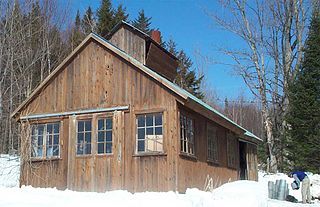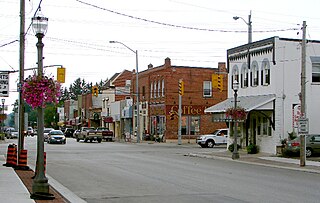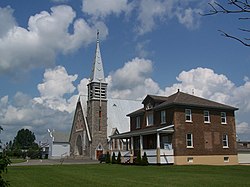
Campbellton is a city in Restigouche County, New Brunswick, Canada.

Thetford Mines is a city in south-central Quebec, Canada. It is the seat of Les Appalaches Regional County Municipality. The city is located in the Appalachian Mountains, 187 km northeast of Montreal and 79 km south of Quebec City. It is known mostly as the asbestos capital of Canada.

The Kortright Centre for Conservation is a suburban conservation area and educational facility in Vaughan, Ontario, Canada in the northern part of the Greater Toronto Area. It is operated by the Toronto and Region Conservation Authority. The area in which it is located is predominantly forested in its western and northern extent. The Humber River is situated in the west and the Cold Creek and Harris Creek are to the north.

Beresford is a geographic parish in Gloucester County, New Brunswick, Canada.

Dundas is a geographic parish in Kent County, New Brunswick, Canada.
Dalhousie is a former town located in Northern New Brunswick. On January 1, 2023, Dalhousie merged with the village of Charlo and all or part of five local service districts (LSDs) to form the new town of Heron Bay, named Baie-des-Hérons in French. Heron Bay is New Brunswick's northernmost point of land.
Kedgwick is a Canadian incorporated rural community in northern New Brunswick, Canada. On 1 January 2023, Kedgwick annexed a large area including the local service districts of St. Jean Baptiste – Menneval and White's Brook, with parts of two others; revised census figures have not been released.

Sugar bush refers to a forest stand of maple trees which is utilized for maple syrup. This was originally an Indigenous camp set up for several weeks each spring, beginning when the ice began to melt and ending when the tree buds began to open. At a traditional sugarbush, all the trees were hand tapped and the sap was boiled over wood fires. The Anishinaabe (Ojibwe) peoples have been doing sugarbush for generations and consider the process both a part of food and of medicine.

A sugar shack, also known as sap house, sugar house, sugar shanty or sugar cabin is an establishment, primarily found in Eastern Canada and northern New England. Sugar shacks are small cabins or groups of cabins where sap collected from maple trees is boiled into maple syrup. They are often found on the same territory as the sugar bush, which is intended for cultivation and production of maple syrup by way of craftsmanship.

Elmvale is a rural town in Springwater Township, Ontario, Canada. It is located at the intersection of County Road 27 and County Road 92, 20 minutes north of Barrie. Elmvale is home to 2,314 people, as of 2016.

Addington is a geographic parish in Restigouche County, New Brunswick, Canada.

Dalhousie is a geographic parish in Restigouche County, New Brunswick, Canada.

Balmoral is a geographic parish in Restigouche County, New Brunswick, Canada.

Eldon is a geographic parish in Restigouche County, New Brunswick, Canada.

Grimmer is a geographic parish in Restigouche County, New Brunswick, Canada.

Saint-Quentin is a geographic parish in Restigouche County, New Brunswick, Canada.

Allardville is a geographic parish in Gloucester County, New Brunswick, Canada,
A regional service commission (RSC) is an administrative entity in the province of New Brunswick, Canada. As the name implies, an RSC administers services on a regional level.

The Canadian province of New Brunswick is divided into 89 local entities, consisting of 77 local governments and 12 rural districts.



















